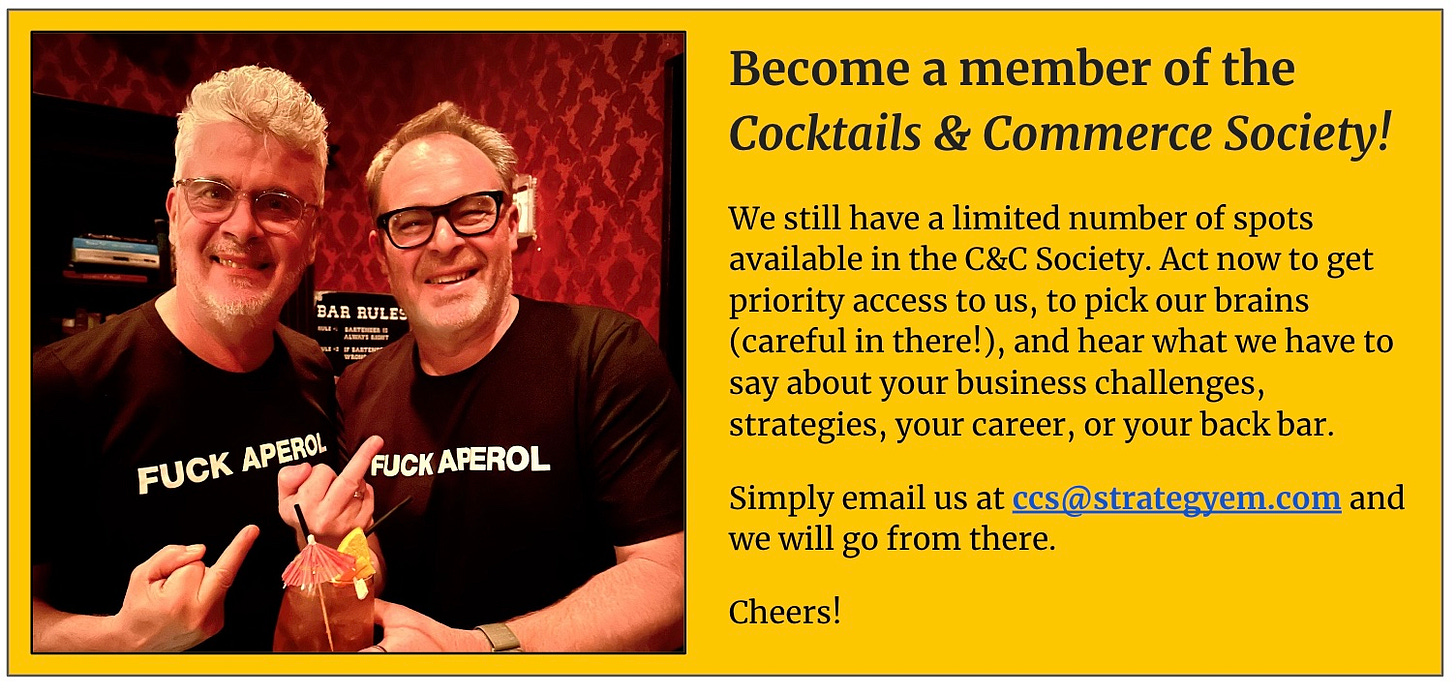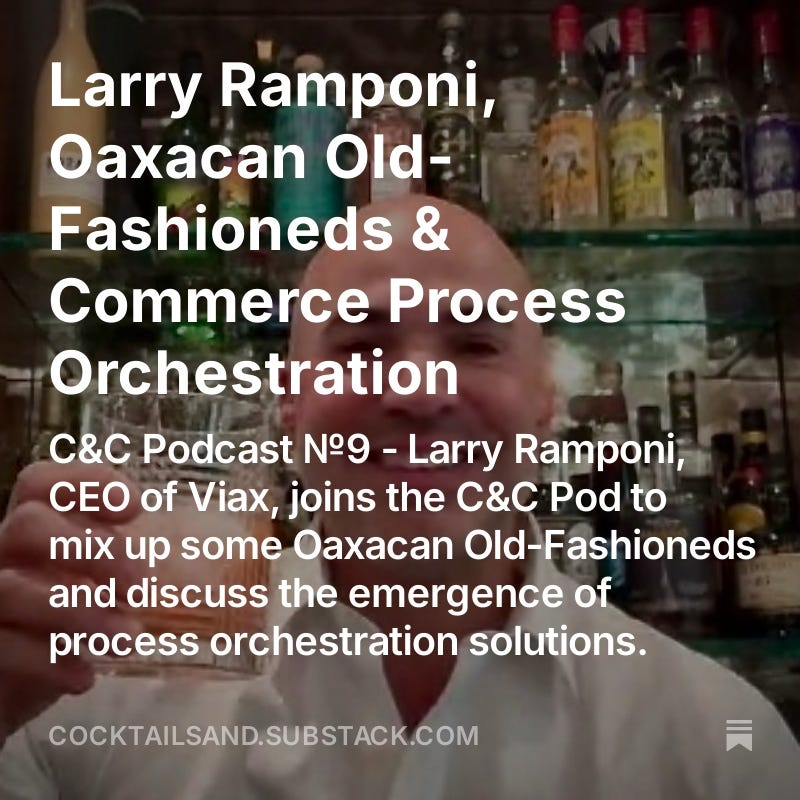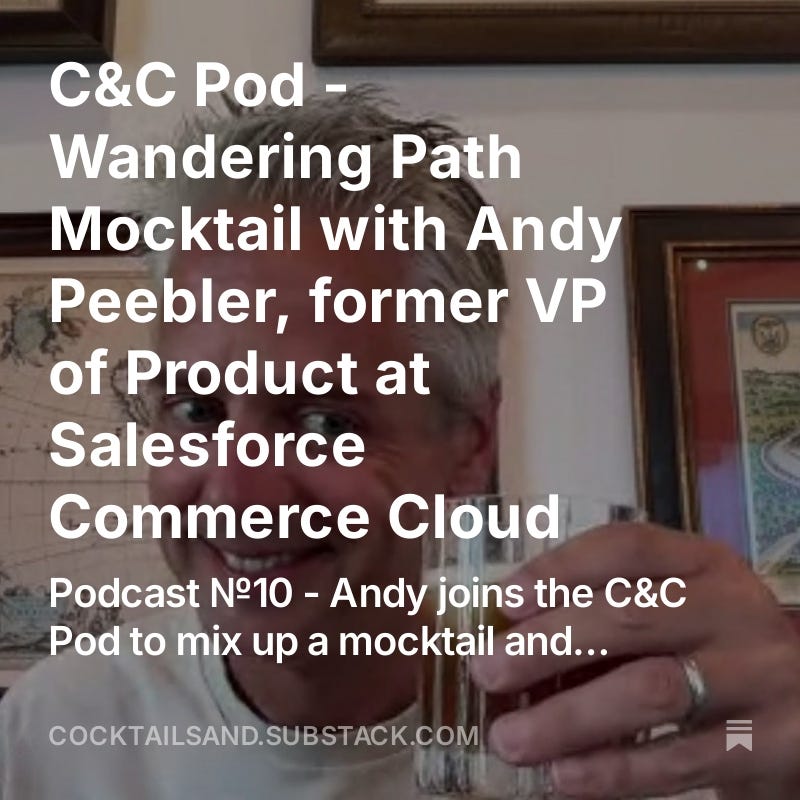A Thanksgiving Dessert Cocktail and How to Reinvigorate GTM with a Refreshed Narrative
Issue №29 - In this issue we pair a ‘Gracias en La Viña’- a great Thanksgiving dessert cocktail - with an exploration into how businesses can reinvigorate their GTM through a refreshed narrative.
Welcome to another edition of Cocktails & Commerce. Thanksgiving is of course just around the corner in the U.S., tomorrow in fact. Whether you are American or not, I hope you have a wonderful weekend and take the opportunity to both reflect and enjoy time with your family and friends, and perhaps take a moment to make a wonderful cocktail and talk about what we are looking forward to together.
Cheers to you and yours!
Cocktail: Gracias en La Viña - a wonderful bespoke Thanksgiving dessert cocktail inspired by a classic
Thanksgiving is just around the corner, tomorrow in fact. This is my favorite holiday of the year; a holiday about gratitude, about family, about reflection and about possibility. It brings people together to not only celebrate the end of the harvest, but to look one another in the eye and share something magical. A chance to share a fabulous meal, full of family traditions - no matter where your family is from or what you all believe - and think hard about what we’re thankful for. Whether you are American or not, I hope you have a wonderful weekend and take the opportunity to both reflect and enjoy time with your family and friends.
For Bill and I, the Thanksgiving holiday brings upon us something we look forward to - satisfying our respective familial duties of pulling together the family Thanksgiving “cocktail programs”. We’ve been busy making syrups and shrubs and getting our proverbial mixology shit together. There are a few mocktails and a few boozy wonders planned - but we also wanted some low-ABV options on the drink cards. These make wonderful welcome drinks, but can also be great for after dinner when everyone is relaxing - or doing the dishes!
It was in search of a low-ABV desert cocktail that we came up with this cocktail, the Gracias en la Viña - “Thanks in the Vineyard”. Gracias en la Viña is designed to serve as both a digestif to be enjoyed on its own, but also to pair well with the pumpkiny, deliciousness that follows the turkey, sweet potatoes, stuffing, brussel spouts, mashed potatoes… Jeez, I’m full already!
The Gracias en la Viña was inspired by a contemporary classic - the La Viña -created at NYC’s Death & Co. by bartender Alex Day back in 2009. Day reached for two of his favorite ingredients, sherry and Amaro Nonino, which are stirred in equal parts with an ounce of rye whiskey and punched with just a dash of orange bitters. Day ended up with what can best be described as a delicious, lighter Manhattan cocktail. It belongs on any list of modern, contemporary, mid-ABV, cocktail hits.
Our riff was born from both necessity and inspiration. First, my sherry collection was short of the East India Solera sherry the original spec called for - and instead I reached for deep, dark flavors of raisins, figs, dates, and molasses found in Pedro Ximénez (PX) sherry. The PX adds depth and bends the La Viña toward desert, while remaining light. Then to add a holiday flair, I reached for Allspice Dram as a sub for the bitters. The Allspice Dram adds baking-spice notes and winter-holiday-vibes - perfect for the rain and cold that has more than set-in here in the Pacific Northwest!
Allspice Dram, a holiday flavor wallop!
Allspice Dram, also known as pimento dram, is a traditional Jamaican liqueur crafted by infusing allspice berries into Jamaican pot-still rum. Native to the Caribbean the berries are known for their complex, intense flavor reminiscent of cloves, anise, cinnamon, and nutmeg.
Allspice Dram has been a staple in Caribbean cuisine for many centuries, but gained much of its notoriety outside of the region during the tiki cocktail movement of the mid-twentieth century where it a tropical spice kick to many seminal tiki cocktails such as the Zombie, Navy Grog, and the Jet Pilot. However, its availability declined in the 1980s, leading to a period where it was nearly impossible to find. Renewed interest in tiki cocktails in recent decades has revived its production, with brands like St. Elizabeth Allspice Dram now featuring in many backbars across the world. But caution, a little goes a long way as it packs a flavor wallop!
In medieval Europe, “dram” referred to a standardized unit of apothecaries' doling out potent liquid medicine - roughly equivalent to 1/8 of an ounce. Many of these were of course preserved with alcohol, and by the sixteenth and seventeenth centuries, the term "dram" came to describe a small serving of spirits or liqueurs - in other words, a shot. And of course, in Scotland still today, "dram" is a colloquial term for a shot of whisky.
This cocktail can also be easily batched to make serving and enjoying it after dinner a breeze when you are laying flat on the living room floor thinking of all the dishes you need to do!
Enjoy! And Happy Thanksgiving to you all!
Cheers!
Gracias en La Viña Cocktail Spec (Serves One)
1 oz (~ 30 ml) - Bourbon or rye whiskey
1 oz (~ 30 ml) - Pedro Ximénez (PX) sherry
1 oz (~ 30 ml) - Amaro Nonino
1.4 oz (~ 7.5 ml) - Allspice Dram (St. Elizabeth Allspice Dram recommended)
Garnish - Orange twist
The process:
Add all ingredients to a mixing glass or pitcher. Stir with ice until well chilled, then strain into a rocks glass or coupe. Express oils from orange twist over glass, then garnish. (Preparation time: 5 minutes.)
Analysis: Hello Darkness, My Old Friend: The root causes of sales downturns, the inevitable response, and what to really do to reinvigorate GTM
It’s a tale as old as time: the economy wavers, technology evolves, the macro-economic environmental conditions turn unfavorable, and sales performance falters. This in many ways is the state of the commerce and digital experience technology market today - with few notable exceptions (Shopify!).
The response is often the same: turn up the pressure on sales and marketing leaders, shuffle the leadership deck chairs, and initiate abrupt changes in go-to-market talent and tactics. Yet, as history shows, these reactions often miss the mark - failing to address the deeper root cause: the need for a new strategy; an overhaul of the value proposition and how to describe the problem you solve.
We are hearing this over and over in the market as people reach out to us to explore their next role - either because they are on the street already, or are anticipating a change may be coming. In many ways, this is natural, it is of course a lot easier to change the GTM team than change the product or the strategy - like firing a coach of a team because you can’t easily fire the players, even if that’s the real problem.

The Reflexive Reaction – Reshuffle the deck chairs, then throw a few of them overboard
When sales forecasts are missed - when net-new customer acquisition fails to meet commitments made to boards and investors - companies instinctively react by scrutinizing sales and marketing. When they lean on their experience and double down on what they know has worked before, when they seem to keep coming up empty quarter after quarter, when they seem out of answers… you know where that leads. Leadership turnover follows as the board or C-suite seeks to find “accountability.” To preserve their standing with the board, or because they are the founder or control the company, the CEO looks behind them and sets a line up. Sometimes this may be for very practical reasons, such as to slow the burn-rate, but often it is a very human response - let’s try something different. And of course, sometimes the CEO themselves is in the deck chair that goes overboard or put in a dingy towed behind - put on the board or in an innocuous role without real authority “to preserve continuity”.
The pressure creates a revolving door of executives but often fails to solve the core issue. The assumption is clear: the problem must lie with the go-to-market execution. What this misses, however, is that sales challenges are often symptoms, not causes. Poor sales performance often really stems from misaligned product-market fit (for today), weak differentiation, or an outdated narrative and value proposition.
And while new leadership may recognize this, it takes time. New leaders get bogged down in operational and organizational hoo-ha - with bringing the organization along, with recruiting the new team, with assessment of the market, with navigating all the constituents within their business. They can provide short-term vigor,and a sense of urgency, but driving strategic realignment can be very hard to do quickly as a new leader - especially if the disruption to the organization and new approach needed is meaningful - yet without it, leadership and staff changes rarely produce long-term growth.
Ditch to ditch - Overcorrection in Go-to-Market Direction
Many years ago, early in my career, I worked as a buyer at a vertically integrated retailer for a guy named John, the GMM. John was an old school, Southern guy who would be right at home at an Auburn or Georgia football tailgate (Fuck Alabama, though he would probably be fine there too). Anyway, when we were making assortment changes and responding to changes in our consumers, John would always caution against over-correction. His saying always stayed with me, “Lets not go ditch to ditch, what we need is to get back on the road.”
Often that is what happens when companies are responding to an acute crisis or simply ‘meh’ result - they go ditch to ditch, yanking on the wheel to get out of one only to careen across the road and end up in the other - on the other side of the road. If you don’t know where you are really headed, this is a risk.
New customer segments you have never served, altered pricing models, ‘consumerish’ marketing, overly aggressive biz dev tactics, bully tactics with partners, or pulling in resources who have had success in other domains but lack a fundamental understanding of the buyer. Occasionally these work, but often they do not and can end up exacerbating problems rather than solve them - leading to further erosion of the existing business, customer base, ecosystem, and ‘vibes’. They end up in the other ditch.
The truth is that companies thrive not by being “better” but by being “different.” It’s not enough to merely tweak existing approaches, find efficiencies, or work harder; organizations must step back, understand their purpose, and articulate a compelling point of view. They need to reframe the market on their terms with a solution that matters - gimmicks and fresh blood will only do so much.
Getting back on the road: Get higher, get clear, have a point-of view
In a challenging market environment it is natural to lean in harder - to double down on what got you here. Arguments over lead-gen, product marketing, qualification, sales execution, win/loss, and demos ensue. Impatience grows despite a collective lack of answers on how to fix what may not actually be broken - the GTM motion. The real issue lay below that, in understanding the problems you solve. Changing the product takes time, but there are near-term actions that can make a real difference - having a narrative that connects customers to your purpose in a way they can see themselves within and which creates urgency.
The most obvious and effective way to uncover this is by talking with your most strategic and compelling customers. CEOs, CMOs, CROs, and CPOs must get out from behind their dashboards and board decks and spend time creating real dialogue with customers. Through that emerges a real understanding of what is top-of-mind and strategic. It is not enough to expect this to funnel up from CSM’s and Account Managers - they are over-subscribed with accounts and putting out fires with the practitioners, and likely only come away with challenges, not opportunities. By getting higher inside these strategic accounts - and “strategic” can mean anything from largest customers to those that represent the future ideal customer - the core of “the problem” emerges. This does not lead to copy-cat tactics and marketing that was inspired by what you competitors did, it leads to differentiation and purpose.
Then the fun can commence, building a narrative that reinvigorates your go-to-market. That narrative should ideally be concise, clear, provocative, and yet empathetic. That narrative will inform your product’s purpose and what qualifies as important. That narrative will enable marketing to “market to the problem” and connect through a differentiated, informed point-of-view that unpacks “the real problem”. That narrative will enable sales to get higher, bring purpose, and create a “vision match”. That narrative will give your company renewed purpose, and make clear what you all really aim to be.
So stop grinding, back up, and focus on the real problems you solve. Then build a narrative around that - or get some help doing just that. Stop selling and marketing the way others are and help customers think differently.
ICYMI - Listen to our latest podcasts!
If you are looking for Brian online, you can find him here, here, and here. And find Bill here and here.
Be well, be safe, and here is to good business! Cheers! - Brian
Cocktails & Commerce™ is a wholly owned subsidiary of StrategyēM, LLC.








